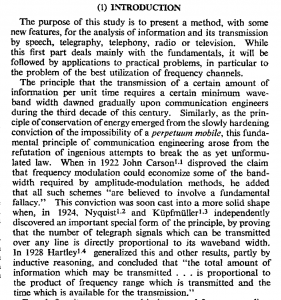If you bought the EE 295 Sketchbook, then you can (if you choose) review topics such as the types of sentences (simple, compound, complex, and compound complex), the ways good paragraphs are put together (with thesis or topic sentences, moving from simpler sentences to more complex ones and then back, and with coherence), and even the ways that sentences can be written to connect to one another helpfully within paragraphs (“connectivity”). Reading for the authors’ rhetorical choices is a new way of seeing, but I think it’s one of the most useful skills to improve your writing over your whole career.
One other thing to take into account, since we’ll be looking at introductory paragraphs, is that the beginning of a journal article tends to establish common ground, state a problem, and explain the writer’s response.
With all that in mind, let’s look at some examples from journal articles in the field.
Gabor’s classic article, “The Theory of Communication” (1946), starts like this:
Notice, of course, how the very first paragraph is straightforward: “the purpose of this study” and the organization of the article are immediately specified. The first sentence is long, but it is just a simple sentence: the purpose is to present a method. All the rest are added phrases. The second sentence is complex, but it’s not a difficult one to figure out. There’s a dependent clause (starting with “while”) and then the main, independent clause.
The second paragraph then moves to one of the main goals of any introduction: establishing common ground. But what else does Gabor achieve here? The paragraph reads as as a short, short review article. This works to establish the writer’s authority. And it’s orderly; it’s a chronological story of how one idea develops off of another. After the first sentence or two, every other one begins with a time period. Usually the main subject is the researcher. Then there are specific and varied verbs: “disproved,” “discovered,” generalized.”
And let me emphasize that it’s a story, a narrative, which is an easy way for readers to process information. The engineers become characters in this story, which make the story easier to understand than if the subjects of the sentences were the inanimate “principles,” “claims,” and “convictions.”
Notice that the first two sentences do start with these inanimate subjects, and this is probably to establish the subject of the whole paragraph: principles of transmission. Notice, too, that the paragraph ends with these words, too; the final sentence contains both “transmitted” and “transmission.” It’s hard to get too far off track when reading this paragraph.
I’ll look at other paragraphs from other articles in future posts.

